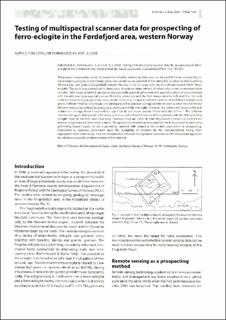| dc.description.abstract | The present investigation aimed to determine remote sensing data can be used in future prospecting for rutile-bearing eclogite. A preliminary study was carried out to establish if the method is suitable for distinguishing different key rock types at Engebøfjell, western Norway, in which large volumes of rutile arehosted within ferroeclogite. The study was carried out in three parts: laboratory measurement of reflectivity curves on representative samples, field measurement of samples using a portable spectral radiometer and spectral analysis of data collected with the airborne hyperspectral scanner. Both the laboratory and the field measurements indicated that the rock surfaces of ferro-eclogite generally have a lower reflectivity compared with the surfaces of both leuco-eclogite and gneiss. Different % reflectivity values in distinct parts of the spectrum can apparently be used as a tool to discriminate between areas characterised by gneiss, leuco-eclogite and ferro-eclogite. However, the presence of moss on the rock surface will change these characteristics significantly and make precise characterisation difficult. The airborne scanner testing was hampered in this study by the unavailability of those bands that proved useful for distinguishing eclogite types in the field and laboratory. However, they are useful in that they reveal a means to discriminate between vegetated and bare rock surfaces. The application of airborne measurement techniques and suitable data processing would appear to be a promising method with potential for routine application in prospecting. Application is, however, dependent upon the availability of channels for the instrumentation being more appropriate than in this study. Also, the considerable influence of vegetation and moss on the data would appear to be critical to successful implementation of the method. | |

